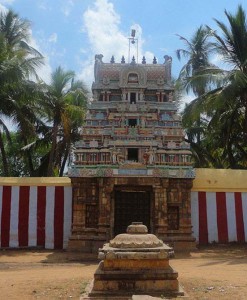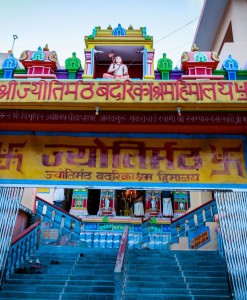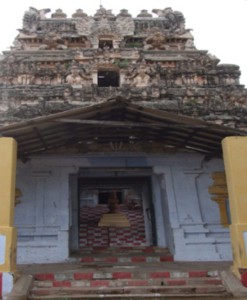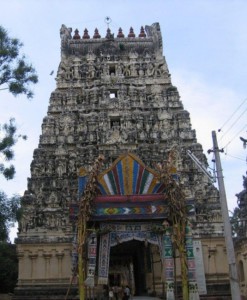No products in the cart.
Badrinath Temple, Uttarakhand
Badrinath Dham is considered form one of the four Char Dham and Chota Char Dham pilgrimage sites. The temple is located in Garhwal hill tracks in Chamoli district along the banks of Alaknanda River at an elevation of 3,133 m (10,279 ft) above the mean sea level. The temple is also one of the 108 Divya Desams dedicated to Vishnu, who is worshipped as Badrinath—holy shrines for Vaishnavites. The name Badrinath was derived from Badri meaning ‘berries’ and Nath meaning ‘Lord’.
The temple finds mention in several ancient books like Bhagavata Purana, Skanda Purana and Mahabharata. According to the Bhagavata Purana, “[t]here in Badrikashram the Personality of Godhead (Vishnu), in his incarnation as the sages Nar and Narayana, had been undergoing great penance since time immemorial for the welfare of all living entities”. The Skanda Purana states that “[t]here are several sacred shrines in heaven, on earth, and in hell; but there is no shrine like Badrinath”. The area around Badrinath Temple is also celebrated in Padma Purana as abounding in spiritual treasures. The Mahabharata revered the holy place as the one which can give salvation to devotees arriving close to if, while in other holy places they must perform religious ceremonies. The temple is revered in Nalayira Divya Prabandham, in 11 hymns in the 7th–9th century Vaishnava canon by Periazhwar and in 13 hymns in Thirumangai Azhwar.
Badrinath Deity
The Badrinath area is referred to as Badari or Badarikaashram in Hindu scriptures. It is a place sacred to Vishnu, particularly in Vishnu’s dual form of Nara-Narayana. Thus, in the Mahabharata, Siva, addressing Arjuna, says, “Thou wast Nara in a former body, and, with Narayana for thy companion, didst perform dreadful austerity at Badari for many myriads of years.”
One legend has it that when the goddess Ganga was requested to descend to earth to help suffering humanity, the earth was unable to withstand the force of her descent. Therefore the mighty Ganga was split into twelve holy channels, with Alaknanda one of them. It later became the abode of Lord Vishnu or Badrinath.
According to the Skanda Purana: “There are several sacred shrines in heaven, on earth, and in hell; but there is no shrine like Badrinath.”
- Architecture
- History and Significance
- Festivals
- Temple Timings and Puja Schedule
- Special Rituals
- How to Reach
- Videos
The structure of the temple as is evident today was built by the Garhwal kings. The temple has three structures; the Garbhagriha (sanctum), the Darshan Mandap (worship hall), and Sabha Mandap (convention hall). The main entrance gate of Badrinath temple is colourful & imposing popularly known as Singhdwar. The conical shaped roof the sanctum, the garbhagriha, is approximately 15 m (49 ft) tall with a small cupola on top, covered with a gold gilt roof. The facade is built of stone and has arched windows. A broad stairway leads up to the main entrance, a tall, arched gateway. Just inside is a mandap, a large, pillared hall that leads to the sanctum, or main shrine area. The walls and pillars of the hall are covered with intricate carvings.
The main shrine houses the 1 m (3.3 ft) Shaligram (black stone) image of Badrinarayan, which is housed in a gold canopy under a Badri Tree. The image of Badrinarayan holds a Shankha (conch) and a Chakra (wheel) in two of its arms in a lifted posture and two arms are rested on its lap in a Yogamudra (Padmasana) posture. The statue is considered by many Hindus to be one of eight swayam vyakta kshetras, or self-manifested statues of Vishnu.
The sanctum also houses images of the god of wealth – Kubera, sage Narada, Uddhava, Nar and Narayan. There are fifteen more images that are also worshipped around the temple. These include that of Lakshmi (the consort of Vishnu), Garuda (the vehicle of Narayan), and Navadurga, the manifestation of Durga in nine different forms. The temple also has shrines of Lakshmi Narasimhar and for saints Adi Shankara (788-820 AD), Vedanta Desika and Ramanujacharya. All the idols of the temple are made of black stone.
The Tapt Kund, a group of hot sulphur springs just below the temple, are considered to be medicinal; many pilgrims consider it a requirement to bathe in the springs before visiting the temple. The springs have a year-round temperature of 55 °C (131 °F), while outside temperature is typically below 17 °C (63 °F) all year round. The two water ponds in the temple are called Narad Kund and Surya Kund.
There is no historical record about the temple, but there is a mention of the presiding deity Badrinath in Vedic scriptures, indicating the presence of the temple during the Vedic period (ca.1750–500 BCE). As per some accounts, the temple was a Buddhist shrine till the 8th century and Adi Shankara converted it to a Hindu temple.
The architecture of the temple resembling that of a Buddhist vihara (temple) and the brightly painted facade which is atypical of Buddhist temples leads to the argument. As per other accounts, it was originally established as a pilgrimage site by Adi Shankara in the ninth century. It is believed that Shankara resided in the place for six years from 814 to 820 AD. He resided six months in Badrinath and the rest of the year in Kedarnath. Hindu followers assert that he discovered the image of Badrinath in the Alaknanda River and enshrined it in a cave near the Tapt Kund hot springs.

A traditional story asserts that Shankara expelled all the Buddhists in the region with the help of the Parmar ruler king Kanak Pal. The hereditary successors of the king governed the temple and endowed villages to meet its expenses. The income from a set of villages on the route to the temple was used to feed and accommodate pilgrims. The Parmar rulers held the title “Bolanda Badrinath”, meaning speaking Badrinath. They had other titles, including Shri 108 Basdrishcharyaparayan Garharj Mahimahendra, Dharmabibhab and Dharamarakshak Sigamani.
The throne of Badrinath was named after the presiding deity; the king enjoyed ritual obeisance by the devotees before proceeding to the shrine. The practice was continued until the late 19th century. During the 16th century, the King of Garhwal moved the murti to the present temple. When the state of Garhwal was divided, the Badrinath temple came under British rule but the king of Garhwal continued as the chairman of the management committee.
The temple has undergone several major renovations due to its age and damage by an avalanche. In the 17th century, the temple was expanded by the Kings of Garhwal. After significant damage in the great 1803 Himalayan earthquake, it was rebuilt by the King of Jaipur. During 2006, the state government announced the area around Badrinath as a no construction zone to curb illegal encroachment.
According to Hindu legend, the god Vishnu sat in meditation at this place, keeping away from Thuling, a place in the Himalayas which was corrupted by meat-eating monks and unchaste people. During his meditation, Vishnu was unaware of cold weather. Lakshmi, his consort, protected him in the form of the Badri tree (jujube or Indian date). Pleased by the devotion of Lakshmi, Vishnu named the place Badrika Ashram. According to Atkinson (1979), the place used to be a jujube forest, which are not found there today. Vishnu in the form of Badrinath is depicted in the temple sitting in the padmasana posture. According to the legend, Vishnu was chastised by a sage, who saw Vishnu’s consort Lakshmi massaging his feet. Vishnu went to Badrinath to perform austerity, meditating for a long time in padmasana.
The Vishnu Purana narrates another version of the origins of Badrinath. According to the tradition, Dharam had two sons, Nar and Narayan —both of which are modern names of Himalayan Mountains. They chose the place to spread their religion and each of them wed the spacious valleys in the Himalayas. Searching for an ideal place to set up a hermitage, they came across the other four Badris of the Pancha Badri, namely Bridha Badri, Yog Bhadri, Dhyan Badri and Bhavish Badri. They finally found the hot and cold spring behind the Alaknanda River and named it Badri Vishal.
The mountains around Badrinath are mentioned in the Mahabharata, where the Pandavas are said to have ended their life by ascending the slopes of a peak in western Garhwal called Swargarohini – literally, the ‘Ascent to Heaven’. Local legend has it that the Pandavas passed through Badrinath and the town of Mana, 4 km north of Badrinath, on their way to Swarga (heaven). There is also a cave in Mana where the great sage Ved Vyasa is believed to have written the epic Mahabharata.
The most prominent festival held at Badrinath Temple is Mata Murti Ka Mela, which commemorates the descent of the river Ganges on mother earth. The mother of Badrinath, who is believed to have divided the river into twelve channels for the welfare of earthly beings, is worshiped during the festival. The place where the river flowed became the holy land of Badrinath.
The Badri Kedar festival is celebrated during the month of June in both the temple and the Kedarnath temple. The festival lasts for eight days; artists from all over the country perform during the function.
Aarti Timings in Badrinath: The daily rituals at the Badrinath temple start very early, around 4.30 am with maha abhishek and abhishek puja, and end at around 8.30 -9 pm with the shayan aarti. The temple opens for darshan for the general public around 7-8 am and there is an afternoon recess between 1-4 pm. The Rawal of the temple performs the rituals. Once again it opens at 4 pm & closes at 9 pm after the divine song Geet Govind.
The temple is managed by the Shri Badrinath Mandir Samiti, constituted in 1939 by the Badrinath Temple Act 16, 1939.
Badrinath Temple Opening and Closing
Generally, The Temple doors are closed around October (dates are fixed on Vijayadashmi) at the advent of winters and are opened again for worship at around last week of April (dates are decided on Basant Panchami ) , in accordance with astrological configurations.
While the temples doors are closed, prayers to the Badri Vishal ‘Utsav Murti’ continue at the Narsimha temple in Joshimath. The priests of Badrinath Temple continue to perform the rituals on the ‘Utsav Murti’ at Narasimha temple during the winter season.
On the day of closure, Akhanda Jyothi, a lamp before the idol in the sanctum is lit filled with ghee to last for six months. The image of Badrinath is notionally transferred during the period to the Narasimha temple at Jyotirmath, located 64 km away from the temple.
It is said that during this period of winter months, Narad Muni who had attained salvation here, continues with the prayer services. This belief is further strengthened based on the fact that when the temple is again reopened after six months in spring, the lamp is still seen to be flickering! Pilgrims gather on the first day of opening of the temple after the winter to witness the Akhanda Jyothi.
Every puja must be preceded by a holy dip in the Tapta Kund. The major religious activities (or pujas) performed every morning are mahabhishek (ablution), abhishek, gitapath and bhagavat puja, while in the evening the pujas include geet govinda and aarti. Recital in vedic scripts like Ashtotram and Sahasranama is practiced during all the rituals. After aarti, the decorations are removed from the image of Badrinath and sandalwood paste is applied to it. The paste from the image is given to the devotees the next day as prasad during the nirmalaya darshan. All the rituals are performed in front of the devotees, unlike those in some Hindu temples, where some practices are hidden from them. Sugar balls and dry leaves are the common prasad provided to the devotees. From May 2006, the practise of offering Panchamrit Prasad, prepared locally and packed in local bamboo baskets, was started.
The Head Pujari of the temple, a Namboodri Brahmin, is known as the Rawal, and is appointed jointly by the former Maharaja of Tehri Garhwal and the Temple Committee. He is the only person who is allowed to touch the idol of the deity. He is assisted by a naib Rawal, who is also a Namboodri Brahmin and the Rawal’s successor. Well versed in Sanskrit and puja rituals, the Rawal must also be celibate.
Special booking of pujas can be done at Badrinath Mandir Committee by paying some fees. The procedures of daily pujas and rituals are supposed to have been prescribed by Adi Shankracharya.
By Road:
Badrinath is connected by motorable roads with other major destinations of the region. To reach Badrinath by road, one has to take NH 58 from Rishikesh via Devprayag, Rudraprayag, Karnaprayag, Nand Prayag, Chamoli, Joshimath and Govindghat. From Rishikesh, Badrinath is 298 Km while from Joshimath, it is 48 Km.
By Rail:
The nearest railway stations to Badrinath are at Rishikesh (300 km), Kotdwara(327 km) and Haridwar. The first two are small stations and are not connected by fast trains. However, Haridwar is connected via the Indian Railway network to major cities in India.
By Air:
The nearest airport to Badrinath is the Jolly Grant Airport in Dehradun. Badrinath lies at a distance of 331 km from Dehradun.
Badrinath Temple, Chamoli, Uttarakhand
One thought on “Badrinath Temple”
Leave a Reply
You must be logged in to post a comment.










Excellent information available. Thanks